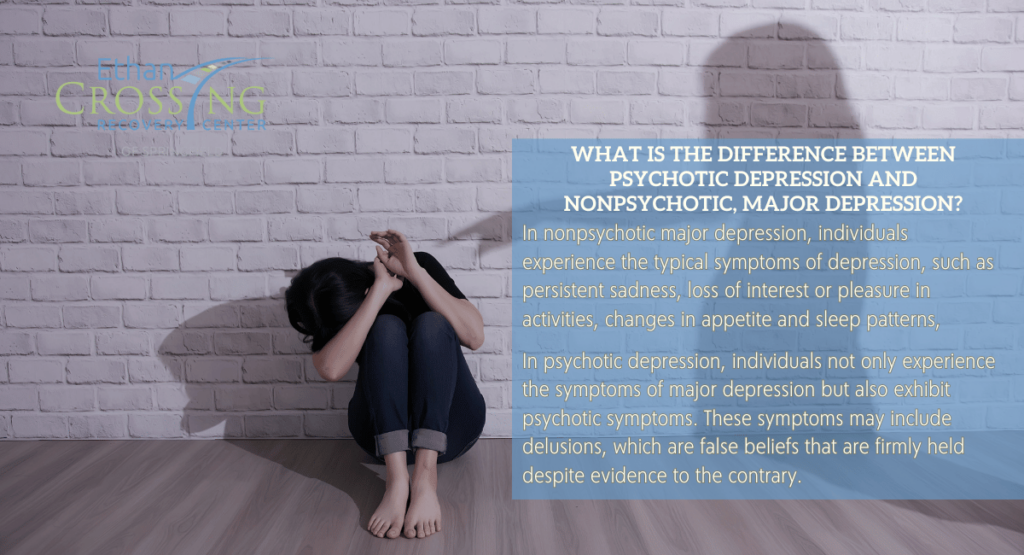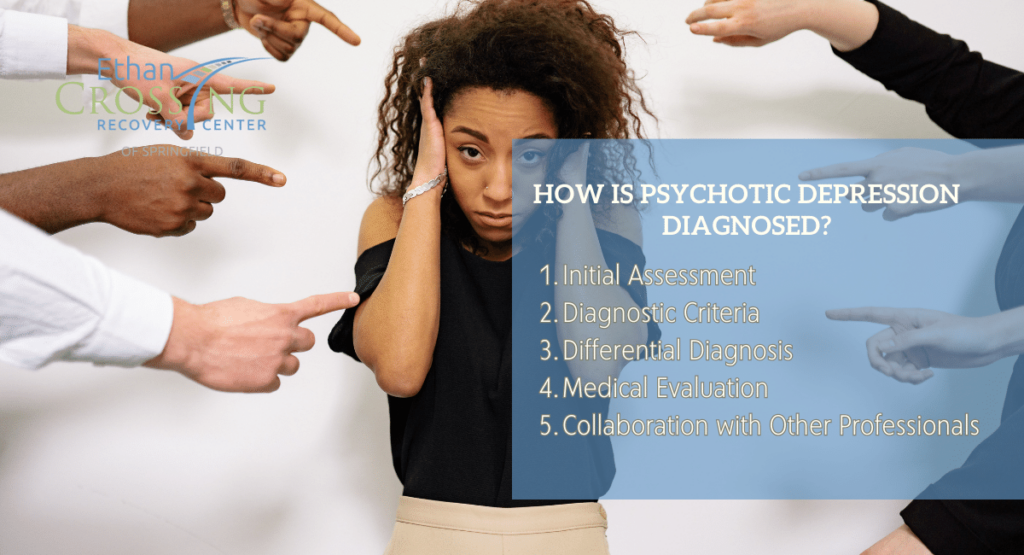Psychotic depression is a distinct and complex mental health condition that combines the symptoms of major depressive disorder with the presence of psychosis. It is characterized by a combination of depressive symptoms along with psychotic features. This condition significantly impacts an individual’s thoughts, emotions, and behaviors, often leading to severe impairment in daily functioning.
The symptoms of psychotic depression include persistent sadness, loss of interest, and feelings of worthlessness, along with mood-congruent hallucinations and delusions.
The exact causes of psychotic depression are not fully understood, but it is believed to result from a combination of genetic, biological, and environmental factors.
The treatment of psychotic depression typically involves a combination of therapy, such as cognitive-behavioral therapy, and medication, including antidepressants and antipsychotics.
Table of Contents
What is Psychotic Depression?
Psychotic depression, also known as major depressive disorder with psychotic features, is a severe form of depression that is characterized by the presence of psychotic symptoms. It is essentially a combination of a major depressive episode and psychosis.
Psychotic depression is a serious condition that requires prompt medical attention. It is often associated with significant impairment in daily functioning and an increased risk of suicide compared to non-psychotic depression due to dangerous hallucinations and delusions.
If you or someone you know is experiencing symptoms of psychotic depression, it is important to seek help from a mental health professional or a healthcare provider. They can provide an accurate diagnosis and develop an appropriate treatment plan to alleviate the symptoms and improve overall well-being.
What is the Difference Between Psychotic Depression and Nonpsychotic, Major Depression?
The main difference between psychotic depression and nonpsychotic major depression lies in the presence or absence of psychotic symptoms.
In nonpsychotic major depression, individuals experience the typical symptoms of depression, such as persistent sadness, loss of interest or pleasure in activities, changes in appetite and sleep patterns, low energy, difficulty concentrating, feelings of guilt or worthlessness, and thoughts of death or suicide. However, they do not experience the additional symptoms of psychosis, such as delusions or hallucinations.
In psychotic depression, individuals not only experience the symptoms of major depression but also exhibit psychotic symptoms. These symptoms may include delusions, which are false beliefs that are firmly held despite evidence to the contrary. For example, a person with psychotic depression may believe they are being persecuted or that they have committed a terrible crime.
Additionally, psychotic depression may involve hallucinations, particularly auditory hallucinations where the person hears voices that are not there. These voices may be critical, insulting, or commanding.
The treatment approaches for psychotic depression and nonpsychotic major depression may also differ. Psychotic depression often requires a combination of antidepressant medications and antipsychotic medications to target both the depressive and psychotic symptoms. Nonpsychotic major depression may be treated primarily with antidepressant medications and psychotherapy, such as cognitive-behavioral therapy (CBT).
What are the Symptoms of Psychotic Depression?
The symptoms of psychotic depression can vary from person to person, but they typically involve a combination of depressive symptoms and psychotic symptoms. Here are the common symptoms associated with psychotic depression:
1. Depressive Symptoms
- Persistent sadness, feelings of emptiness, or hopelessness
- Loss of interest or pleasure in activities once enjoyed
- Significant weight loss, weight gain, or changes in appetite
- Insomnia (difficulty sleeping) or hypersomnia (excessive sleepiness)
- Fatigue or loss of energy
- Feelings of worthlessness or excessive guilt
- Difficulty concentrating or making decisions
- Recurrent thoughts of death or suicide, or suicide attempts
2. Psychotic Symptoms
- Delusions: Delusions in psychotic depression often revolve around themes of personal inadequacy, guilt, or punishment. For example, a person experiencing depressive thoughts of worthlessness and self-blame may develop delusions that they are responsible for causing harm to others or that they deserve punishment for supposed wrongdoings. The delusions are typically congruent with the person’s negative self-perception and depressive mindset.
- Hallucinations: In psychotic depression, auditory hallucinations are the most common type. These hallucinations typically involve hearing voices that are critical, derogatory, or commanding. The content of the voices often reflects the person’s negative self-perception and depressive thoughts. For instance, the voices may insult the person, reinforce feelings of guilt, or command them to engage in self-harm. The hallucinations further amplify the distress and reinforce the depressive themes already present.
It’s important to note that the hallucinations and delusions experienced in psychotic depression are usually consistent with the person’s depressive themes and emotional state.
What are the Causes of Psychotic Depression?
The exact causes of psychotic depression are not fully understood. However, like other mental health conditions, it is likely influenced by a combination of biological, psychological, and environmental factors. Here are some factors that may contribute to the development of psychotic depression:
1. Biological Factors
- Genetics: Having a family history of depression or psychotic disorders may increase the risk of developing psychotic depression. Certain genes or genetic variations may play a role in the vulnerability to the condition. According to research by PubMed, a family history of psychosis and bipolar disorder has been identified as a risk factor for psychotic depression
- Brain Chemistry: Imbalances in certain neurotransmitters, such as serotonin, norepinephrine, and dopamine, have been associated with depression and psychosis. Disruptions in these neurotransmitter systems may contribute to the development of psychotic depression.
2. Psychological Factors
- Stress and Trauma: Experiences of significant stress, trauma, or adverse life events can increase the risk of developing depression, and in some cases, psychotic depression. Traumatic events may trigger the onset of symptoms or exacerbate existing depressive symptoms.
- Cognitive Factors: Negative thinking patterns, low self-esteem, and distorted beliefs about oneself and the world can contribute to the development or maintenance of depressive symptoms in psychotic depression.
3. Environmental Factors
- Social Support: Lack of social support or strained interpersonal relationships can contribute to the development of depression, including psychotic depression.
- Life Circumstances: Difficult life circumstances, such as financial problems, relationship difficulties, or chronic illness, can increase the risk of developing depression and may also contribute to the emergence of psychotic symptoms.
These factors interact with each other, and the development of psychotic depression is likely a complex interplay between genetic predisposition, biological factors, psychological vulnerabilities, and environmental stressors.
How is Psychotic Depression Diagnosed?
The diagnosis of psychotic depression involves a comprehensive evaluation by a mental health professional, typically a psychiatrist or a psychologist. The diagnostic process typically includes the following components:
1. Initial Assessment
The mental health professional will conduct an initial assessment to gather information about the individual’s symptoms, medical history, family history, and any relevant psychosocial factors. This may involve interviews with the individual and, if available, collateral information from family members or close contacts.
2. Diagnostic Criteria
The mental health professional will refer to the Diagnostic and Statistical Manual of Mental Disorders (DSM-5), which provides criteria for diagnosing mental health conditions, including psychotic depression. To receive a diagnosis of psychotic depression, the individual must meet the criteria for a major depressive episode as well as experiencing psychotic symptoms, such as delusions or hallucinations.
3. Differential Diagnosis
The mental health professional will consider other possible explanations for the symptoms, ruling out other conditions that may present with similar features, such as bipolar disorder with psychotic features, schizoaffective disorder, or substance-induced psychosis. The differentiation between psychotic depression and other conditions is important for determining the most appropriate treatment approach.
4. Medical Evaluation
A medical evaluation may be conducted to rule out any underlying medical conditions or medication side effects that could be contributing to the symptoms. Certain medical conditions, such as thyroid disorders or certain neurological conditions, can mimic or exacerbate depressive or psychotic symptoms.
5. Collaboration with Other Professionals
In some cases, the mental health professional may collaborate with other healthcare providers, such as a primary care physician or a neurologist, to gather additional information or to ensure a comprehensive assessment.
The diagnostic process for psychotic depression requires a trained professional who can carefully evaluate the symptoms and make an accurate diagnosis.
What are the Treatment Options for Psychotic Depression?
The treatment options for psychotic depression typically involve a combination of therapy and other forms of treatment, including medication. Here’s an overview of the available treatment options:
1. Therapy
- Psychotherapy: Psychotherapy, such as cognitive-behavioral therapy (CBT) or psychodynamic therapy, can be beneficial for individuals with psychotic depression. These therapies help individuals identify and modify negative thought patterns, develop coping skills, and address underlying emotional issues.
- Supportive Therapy: Supportive therapy focuses on providing emotional support, empathy, and guidance to individuals with psychotic depression. It helps individuals cope with their symptoms, manage stress, and improve overall well-being.
2. Medication
- Antidepressant Medications: Antidepressant medications, such as selective serotonin reuptake inhibitors (SSRIs) or tricyclic antidepressants (TCAs), are commonly prescribed to treat the depressive symptoms of psychotic depression. These medications help regulate mood and alleviate symptoms of depression.
- Antipsychotic Medications: Antipsychotic medications are often prescribed to target the psychotic symptoms, such as delusions and hallucinations, in psychotic depression. They help reduce the intensity and frequency of psychotic symptoms. Atypical antipsychotics are commonly used due to their effectiveness and lower risk of side effects compared to older, typical antipsychotics.
3. Electroconvulsive Therapy (ECT)
In severe cases of psychotic depression or when other treatments have not been effective, electroconvulsive therapy (ECT) may be considered. ECT involves administering controlled electrical currents to the brain to induce a brief seizure. It is highly effective in treating severe depression with psychotic features.
4. Hospitalization
In cases where psychotic depression is severe and there is a risk of self-harm, suicide, or significant impairment, hospitalization in a psychiatric facility may be necessary. This allows for intensive monitoring, stabilization, and a structured treatment environment.
The choice of treatment depends on the individual’s specific symptoms, severity of the condition, treatment response, and personal preferences. A comprehensive evaluation by a mental health professional is crucial to determine the most appropriate treatment plan.
What is Psychosis?
Psychosis is a mental state characterized by a significant impairment in an individual’s perception of reality. It involves a disturbance in thinking, perception, emotions, and behavior. People experiencing psychosis may have difficulty differentiating between what is real and what is not.
Key features of psychosis include:
- Delusions
- Hallucinations
- Disorganized Thinking and Speech
- Disrupted Emotions and Behavior
Psychosis can occur as a symptom of various mental health conditions, including schizophrenia, schizoaffective disorder, bipolar disorder, and severe depression with psychotic features. It can also be induced by substance abuse, certain medical conditions, or as a side effect of medications.
Psychotic Depression vs. Schizophrenia
The treatment of psychotic symptoms aims to reduce their intensity, frequency, and impact on daily functioning rather than seeking a complete cure. Psychotic symptoms, such as hallucinations or delusions, are often associated with underlying psychiatric disorders like schizophrenia, schizoaffective disorder, or psychotic mood disorders.
These conditions can be chronic, requiring ongoing management and treatment. However, with appropriate treatment and support, many individuals can experience significant symptom improvement and lead fulfilling lives. Treatment approaches typically involve a combination of medication, therapy, and psychosocial interventions.
Bottom Line
Psychotic depression is a subtype of major depressive disorder characterized by depressive symptoms and psychotic features like hallucinations and delusions. It requires a combination of therapy and medication for treatment. Therapy, such as cognitive-behavioral therapy, helps individuals challenge negative thoughts and develop coping strategies.
Antidepressant and antipsychotic medications are commonly prescribed to alleviate depressive symptoms and manage psychosis. Early intervention and ongoing support from qualified professionals are crucial for effective management. With proper diagnosis and treatment, individuals with psychotic depression can experience symptom relief and an improved quality of life.













